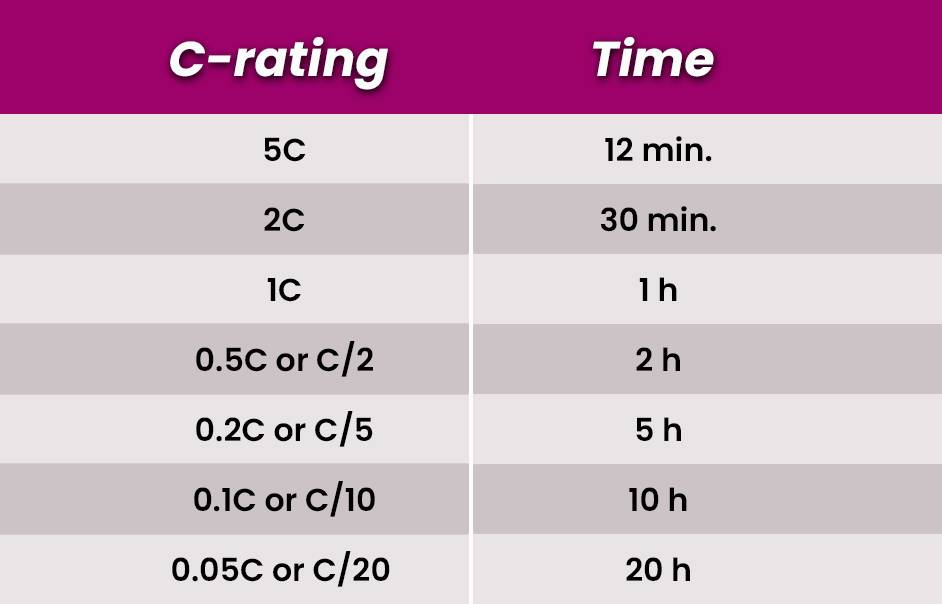Deciphering the Mysteries of Battery C Rating
Introduction
Have you ever wondered what those cryptic letters and numbers associated with batteries mean? You're not alone. Understanding battery specifications, especially the C rating, can seem like deciphering a secret code. But fear not, as we embark on this journey together to demystify the concept of Battery C Rating.
Unraveling the Basics: What is Battery C Rating?
Before diving into the complexities, let's grasp the fundamentals. The C rating of a battery is a measure of its discharge rate capacity. In simpler terms, it indicates how much current a battery can deliver relative to its capacity. This rating plays a crucial role in various applications, from RC hobbies to electric vehicles, determining the performance and efficiency of the power source.
The Significance of C Rating
The C rating serves as a vital parameter for selecting the right battery for a specific application. It determines the maximum safe discharge rate, ensuring optimal performance without damaging the battery. Essentially, a higher C rating implies a greater capability to deliver power swiftly, which is indispensable in high-performance scenarios.
Cracking the Code: Understanding C Rating Numbers
Now that we comprehend the essence of C rating, let's delve deeper into deciphering its numerical representation.
Understanding C Rating Numbers
C ratings are typically expressed as a numerical value followed by the letter 'C,' such as 10C or 20C. This number signifies the multiple of the battery's capacity that it can discharge safely. For instance, a 10C rating means the battery can discharge at a rate equivalent to ten times its capacity.
Interpreting Practical Scenarios
To put this into perspective, consider a battery with a capacity of 1000mAh (milliampere-hour) and a C rating of 10C. In this case, the maximum safe discharge current would be 10 times the capacity, i.e., 10,000mA or 10A (since 1 Ampere equals 1000 milliamperes). Similarly, a battery with a capacity of 2000mAh and a 20C rating would have a maximum safe discharge current of 40A.
Calculating Discharge Current: Simple Formulas
Equipped with the understanding of C rating, let's explore some basic formulas to calculate discharge current effortlessly.
Formula 1: Calculating Maximum Discharge Current
The formula to calculate the maximum discharge current is straightforward:
Formula 2: Determining Battery Capacity
Conversely, if you know the maximum discharge current and the C rating, you can determine the battery capacity using this formula:
Practical Implications: Why Does C Rating Matter?
Understanding C rating is not merely about deciphering technical jargon; it holds practical significance in various applications.
Optimizing Performance
Choosing the right C rating ensures optimal performance of your devices or applications. Using a battery with an insufficient C rating may lead to voltage sag, reduced efficiency, or even damage under high load conditions.
Enhancing Safety
Selecting a battery with an appropriate C rating is crucial for safety. Exceeding the maximum discharge rate can strain the battery, leading to overheating, swelling, or, in extreme cases, explosion or fire hazards.
Maximizing Lifespan
Properly matching the C rating to the application requirements can prolong the lifespan of the battery. Operating within the recommended parameters minimizes stress on the cells, preserving their capacity and longevity.
Conclusion
In conclusion, understanding and calculating Battery C Rating is essential for anyone utilizing rechargeable batteries in their devices or projects. By grasping the significance of C rating, interpreting its numerical representation, and employing simple formulas for calculation, you can ensure optimal performance, safety, and longevity of your batteries. So, the next time you encounter those enigmatic C ratings, you'll be equipped to decipher their mysteries with confidence.
FAQs
Q1: Can I exceed the C rating of a battery?
A1: Exceeding the C rating of a battery can lead to overheating, voltage sag, and even damage. It's crucial to operate within the specified limits for optimal performance and safety.
Q2: How does temperature affect battery C rating?
A2: Temperature plays a significant role in battery performance. High temperatures can increase the internal resistance of the battery, reducing its effective C rating, while low temperatures can decrease its capacity.
Q3: What is the relationship between C rating and battery chemistry?
A3: Different battery chemistries have varying C rating capabilities. For example, lithium-ion batteries typically have higher C ratings compared to lead-acid batteries due to their superior power density.
Q4: How do I choose the right C rating for my application?
A4: Selecting the appropriate C rating depends on the specific requirements of your application, including the maximum current draw and desired performance. It's essential to match the C rating to your application's needs to ensure optimal functionality.
Q5: Can I calculate the C rating of a battery from its specifications?
A5: While C rating is often provided by manufacturers, calculating it from the battery specifications is challenging without additional information about the internal construction and chemistry. It's best to rely on the manufacturer's specified C rating for accuracy and safety.

.png)


Comments
Post a Comment